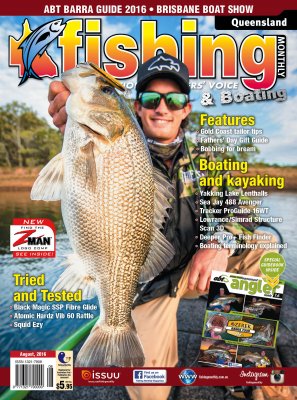Breaking down the basics of Gold Coast tailor by Josh Dunn
 Winter is prime time for many of species, when Broadwater and the early parts of the canals fire up. Tailor, Pomatomus saltatrix, pop into mind when I think of winter, trolling hardbody lures throughout parts of the Broadwater. So let's break it down into a few easy points to help you get onto a few chopper tailor!
Winter is prime time for many of species, when Broadwater and the early parts of the canals fire up. Tailor, Pomatomus saltatrix, pop into mind when I think of winter, trolling hardbody lures throughout parts of the Broadwater. So let's break it down into a few easy points to help you get onto a few chopper tailor!
Mainly caught from June to February, winter proves most successful for catching tailor. Tailor are hard fighting, predatory fish renowned for their razor sharp teeth. They have almost the best set of dentures in the game and are known to engulf lures, slicing the leader, so be prepared to lose some tackle.
It gets expensive using premium lures, and you'll want to have them hooked in the rear treble! If you aren't keen on losing money on these fish, buy cheaper models and add some premium split rings and trebles. Despite the loss, tailor fishing can be seriously fun!
THE GEAR
You don't have to purchase surf combos and surf fishing gear to get onto tailor. You probably already have the gear in your garage storage area. Don't make fishing too complicated, though. A graphite rod between 2-4kg and 3-5kg will do the job. Match that with a reel size around 2500-3000, but not much lighter as you want to have some drag on the fish. Don't go heavier either. Add braided lines like Powerpro, Daiwa J-Braid, Sunline and Spiderwire around 10-20lb.
For your fluorocarbon leader, 15lb is perfect for this style of fishing. If you find it's too light, try using 20lb. My usual setup consists of a Shimano Raider 3-6kg or a 2-5kg ACM Custom, size 3000 with Sustain FG, 20lb Sunline braid and 20lb fluorocarbon leader. This setup is great for flathead fishing too. Tailor love movement, so the more you can get in your lure from your rod, the better the result and hook-up will be.
LURES
There's a heap of lures on the market that will do a great job, catch fish and also break the bank. Hardbody lures can be $10-$30, even $40. Mostly there is great quality in high priced lures, but there are cheaper options that are just as effective. Lures can be broken into three sub-groups: soft plastics, hardbodies and slugs (surface and divers). Some successful lures and colours - that won't cost you a fortune - are Lucky craft G-Splash (for surface), Z-man 3" MinnowZ in Opening Night, Rapala X-Rap (Saltwater 120mm in silver blue mackerel), 9cm Rapala Skitter Pop and some of the ZipBaits minnows.
The metal lures and slugs are mainly for bust-ups when tailor are feeding on the surface. These are retrieved at a fast pace, so you don't need anything special. When fish see flashy metal they'll automatically think baitfish. I know of people who have used a spoon or wrench, with some maintenance, and actually caught fish on it! However, choosing a lure that swims properly is vital. Raiders, Lazers and Gillies metal lures are just a few of my favourite, at around $4.95 each. The weight of slugs depends on your tackle, but 15-25gm will work perfect.
SPOTS
Some areas on the Gold Coast fish better than others. Do your research, read magazines like this one and follow up on social media to find where the fish are biting. Broadwater, the Seaway and early parts of the canals will produce larger tailor. Deeper in the estuaries, you'll find the smaller fish searching for protection from larger species. Greenback tailor are usually larger than 60cm and 2.5kg, and are generally found in the Seaway and around headlands.
The north and south wall of the Seaway fish great in the early morning and late afternoons. Look for signs of birds working in the area and patches of bait on your sounder. Sometimes you will get small fish before you get onto the larger models.